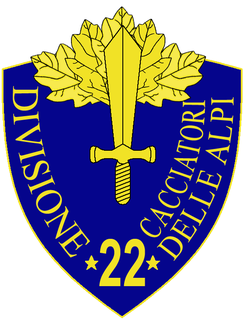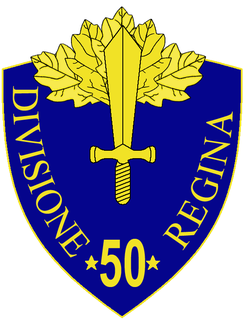History
As part of the Italian I Corps, the Cagliari participated in the Italian invasion of France in June 1940. Initially (10 June 1940) staying on the border at the Mont Cenis-Monte Niblè-Rocciamelone line, the division have moved across border 15 June 1940, capturing Dents d'Ambin, Sommet de la Nunda, Pas de la Beccia and Col de Sollières around Mont Cenis lake by 17 June 1940. On 21 June 1940 it reached the Arc river valley and started advancing to Bramans and Le Planey (on Ruisseau d'Étache stream), capturing both on 23 June 1940. Immediately attack was initiated to Val d'Ambin with the goal of Modane, but the Franco-Italian Armistice signed 24 June 1940 has stopped the Cagliary division short of this goal. The division remained in the Arc valley until the end of September, when it returned home to Italy.
On 21 January 1941, the orders were received to move to Albania. The Cagliari division completed its transfer to Berat on 31 January 1941, joining the Italian VIII Corps for the ongoing Greco-Italian War. First contact with the Greek forces was made on 8 February 1941 near Berat, with the clashes at Mali i Tërpanit and Paraspuar following soon. On 12 February 1941 the front had stabilised from Qafa e Bubësit to positions in valleys of Osum and Tomorrica rivers. On 11 March 1941, as part of the Italian Spring Offensive, after prolonged period of defence, the Cagliari division commenced attacks on Bubës, capturing it on 13 March 1941, but was unsuccessful in the assaults on Monastery Hill (Height 731) a few kilometers south during 14–19 March 1941. As a result of Greek units disengaging after the start of the German invasion of Greece on 6 April 1941, the Cagliari division advanced to the ridge overlooking Këlcyrë Gorge from north on 15 April 1941, overcoming some Greek rearguard resistance. On 18 April 1941 it continued pursuit to Përmet, and reached the pre-war border stream of Perati on 20 April 1941, where some Greek rearguard once more tried to make a stand. After the end of active fighting, it was used as occupation force in Kalpaki. In June 1941, the division was transferred to the southern Peloponnese. Main garrisons were established in Tripoli, Kalamata and Sparta, performing mopping-up and anti-partisan duties. The division disintegrated following announcement of the Armistice of Cassibile on 8 September 1943.

The 29th Infantry Division Piemonte was an infantry division of the Royal Italian Army during World War II. Originally raised with the name 29th Infantry Division Peloritani, the division fought in Ethiopia during the interwar period. The division was reorganized as the binary 29th Infantry Division Piemonte on 15 April 1939, and fought in Greece. Initially garrisoned in Messina, Sicily, the division was made up entirely of Sicilians.

The 24th Infantry Division Pinerolo was an infantry division of the Italian Army during World War II.

The 26th Infantry Division Assietta was a mountain infantry Division of the Italian Army during World War II. The Assietta Division was reorganized 5 April 1939 as a binary Mountain division. The only difference between line infantry divisions and mountain infantry divisions was that the latter's artillery was carried by pack mules instead of the standard horse-drawn carriages. Italy's real mountain warfare divisions were the six alpine divisions manned by the "Alpini" mountain troops. Most men drafted in the Assietta Division came from Asti and surroundings.

The 9th Infantry Division Pasubio was an auto-transportable binary-type (2-regiments) Infantry Division of the Italian Army during World War II. The division was formed as an infantry division in 1934, reorganized into an infantry division in 1939 and mobilized in August 1940. Its 79th Infantry Regiment and 8th Artillery Regiment were made up of men from Verona, while the ranks of the 80th Regiment were filled with men from Mantua. Its 1st Sabauda CCNN Battalion was made up of volunteers from Turin.

The 6th Infantry Division Cuneo was an infantry division of the Italian Army during World War II. The Division was formed on 24 May 1939 in Milan, largely from the parts of 58th Infantry Division Legnano. The Cuneo Division was part of the III Corps, First Army that took part in the Italian invasion of France and the 26th Corps during Greco-Italian War.

The 11th Infantry Division Brennero was a mountain infantry division of the Italian Army during World War II. The Brennero Division was mobilized in October 1939, demobilized in October, 1940, and mobilized again in December, 1940. The only difference between line infantry divisions and mountain infantry divisions was that the latter's artillery was carried by pack mules instead of the standard horse-drawn carriages. Italy's real mountain warfare divisions were the six alpine divisions manned by the "Alpini" mountain troops. It began transformation to motorized division in February, 1943.

The 22nd Infantry Division Cacciatori delle Alpi was an infantry division of the Italian Army during World War II. The Cacciatori delle Alpi was mobilized for war in June 1939 and was dissolved 11 September 1943.

The 23rd Infantry Division Ferrara was a mountain infantry division of the Italian Army during World War II. It was formed as division Murgia 28 March 1939. The name was changed to Ferrara 24 May 1939. The only difference between line infantry divisions and mountain infantry divisions was that the latter's artillery was carried by pack mules instead of the standard horse-drawn carriages. Italy's real mountain warfare divisions were the six alpine divisions manned by the "Alpini" mountain troops. After the Italian surrender to the Allies in September 1943, the Division surrendered to the Germans. Its men were drafted in Bari and in the Murge.

The 31st Infantry Division Calabria was an infantry division of the Italian Army during World War II. The Calabria Division, formed from the 31st Infantry Brigade "Caprera" 15 October 1939, was part of the garrison at Sardinia where it remained until it surrendered to the Allies after the Italian surrender in September 1943. The Division would then serve on the Allied side until the end of the war.

The 37th Infantry Division Modena was a mountain Infantry Division of the Italian Army during World War II. It was formed 25 March 1939, from the parts of the Territorial Division Imperia 5a. It was made up entirely of men from Genoa and Liguria. The only difference between line infantry divisions and mountain infantry divisions was that the latter's artillery was carried by pack mules instead of the standard horse-drawn carriages. Italy's real mountain warfare divisions were the six alpine divisions manned by the "Alpini" mountain troops.

The 38th Infantry Division Puglie was a mountain infantry division of the Italian Army during World War II. The Puglie Division was mobilized 15 May 1939 and disintegrated soon after 8 September 1943. The division filled its ranks with men drafted in eastern Veneto and Friuli, with a majority of soldiers hailing from the towns of Sacile and Vittorio Veneto. The only difference between line infantry divisions and mountain infantry divisions was that the latter's artillery was carried by pack mules instead of the standard horse-drawn carriages. Italy's real mountain warfare divisions were the six alpine divisions manned by the "Alpini" mountain troops.

The 40th Infantry Division "Cacciatori d’Africa" was an infantry division of the Italian Army during World War II. It was formed 27 July 1940 and dissolved 15 May 1941. The divisions Cacciatori d’Africa and 65 Infantry Division Granatieri di Savoia were outside of the normal chain of command, being subordinated directly to Prince Amedeo, Duke of Aosta., together with other colonial troops in Italian East Africa.

The 41st Infantry Division Firenze was an infantry division of the Italian Army during World War II. It was formed 15 September 1939 in Florence and was officially dissolved 28 September 1943.
The division was made up of Tuscans, and especially Florentines.

The 48th Infantry Division Taro was an infantry division of the Italian Army during World War II. It was formed on 12 September 1939 in Catanzaro and ceased to function on 8 September 1943 in Toulon.

The 49th Infantry Division Parma was an infantry division of the Italian Army during World War II. The Parma Division was a regular division of the Italian Army, formed 12 September 1939 in Macerata, and dissolved 8 September 1943 in Vlorë.

The 50th Infantry Division Regina was an infantry division of the Italian Army during World War II. The Regina Division was a regular division of the Italian Army. It was formed on 1 March 1939 in the Italian Islands of the Aegean and formally dissolved in the same place 11 September 1943, although some sub-units continued to fight until 16 November 1943.

The 51st Infantry Division Siena was a regular infantry division of the Italian Army during World War II. The Siena Division was formed 15 September 1939 and dissolved 8 September 1943. Historically a Campanian unit, it was made almost entirely of Neapolitans.

The 53rd Infantry Division Arezzo was a mountain infantry division of the Italian Army during World War II. It was formed 24 May 1939 and officially dissolved 12 September 1943. The Arezzo division is not related to partisan division Arezzo operating in 1943 in the Cortona vicinity under command of Siro Rossetti. The only difference between line infantry divisions and mountain infantry divisions was that the latter's artillery was carried by pack mules instead of the standard horse-drawn carriages. Italy's real mountain warfare divisions were the six alpine divisions manned by the Alpini mountain troops.

The 56th Infantry Division Casale was a regular Infantry Division of the Italian Army during World War II. It was formed in 1939 in Forlì and was dissolved in September 1943 in Aetolia-Acarnania region of Greece. The majority of its men originated from Romagna.
This page is based on this
Wikipedia article Text is available under the
CC BY-SA 4.0 license; additional terms may apply.
Images, videos and audio are available under their respective licenses.




















